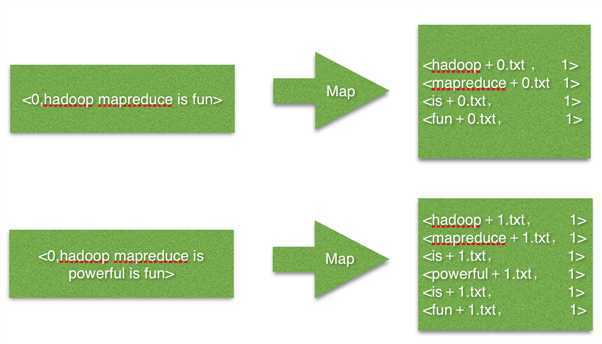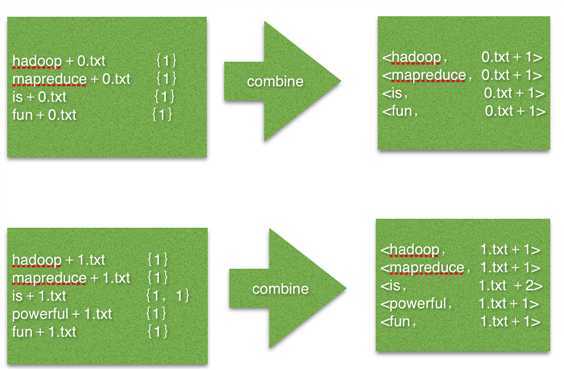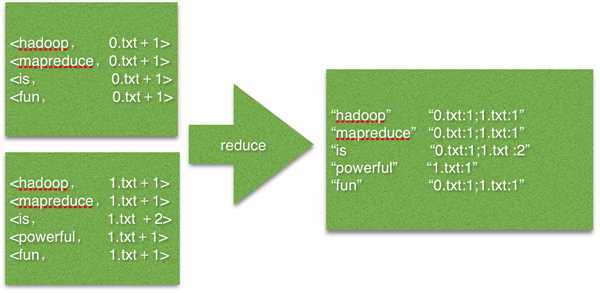标签:
1.前言
学习hadoop的童鞋,倒排索引这个算法还是挺重要的。这是以后展开工作的基础。首先,我们来认识下什么是倒拍索引:
倒排索引简单地就是:根据单词,返回它在哪个文件中出现过,而且频率是多少的结果。这就像百度里的搜索,你输入一个关键字,那么百度引擎就迅速的在它的服务器里找到有该关键字的文件,并根据频率和其他一些策略(如页面点击投票率)等来给你返回结果。这个过程中,倒排索引就起到很关键的作用。
2.分析设计
倒排索引涉及几个过程:Map过程,Combine过程,Reduce过程。下面我们来分析以上的过程。
2.1Map过程
当你把需要处理的文档上传到hdfs时,首先默认的TextInputFormat类对输入的文件进行处理,得到文件中每一行的偏移量和这一行内容的键值对<偏移量,内容>做为map的输入。在改写map函数的时候,我们就需要考虑,怎么设计key和value的值来适合MapReduce框架,从而得到正确的结果。由于我们要得到单词,所属的文档URL,词频,而<key,value>只有两个值,那么就必须得合并其中得两个信息了。这里我们设计key=单词+URL,value=词频。即map得输出为<单词+URL,词频>,之所以将单词+URL做为key,时利用MapReduce框架自带得Map端进行排序。
下面举个简单得例子:

图1 map过程 输入/输出
2.2 Combine过程
combine过程将key值相同得value值累加,得到一个单词在文档上得词频。但是为了把相同得key交给同一个reduce处理,我们需要设计为key=单词,value=URL+词频

图2 Combin过程 输入/输出
2.3Reduce过程
reduce过程其实就是一个合并的过程了,只需将相同的key值的value值合并成倒排索引需要的格式即可。

图3 reduce过程 输入/输出
3.源代码
package reverseIndex; import java.io.IOException; import java.util.StringTokenizer; import org.apache.hadoop.conf.Configuration; import org.apache.hadoop.fs.Path; import org.apache.hadoop.io.Text; import org.apache.hadoop.mapreduce.Job; import org.apache.hadoop.mapreduce.Mapper; import org.apache.hadoop.mapreduce.Reducer; import org.apache.hadoop.mapreduce.lib.input.FileInputFormat; import org.apache.hadoop.mapreduce.lib.input.FileSplit; import org.apache.hadoop.mapreduce.lib.output.FileOutputFormat; import org.apache.hadoop.util.GenericOptionsParser; public class InvertedIndex { public static class InvertedIndexMapper extends Mapper<Object, Text, Text, Text>{ private Text keyInfo=new Text(); private Text valueInfo=new Text(); private FileSplit split; public void map(Object key,Text value,Context context)throws IOException,InterruptedException { //获得<key,value>对所属的对象 split=(FileSplit)context.getInputSplit(); StringTokenizer itr=new StringTokenizer(value.toString()); while (itr.hasMoreTokens()) { //key值有单词和url组成,如"mapreduce:1.txt" keyInfo.set(itr.nextToken()+":"+split.getPath().toString()); valueInfo.set("1"); context.write(keyInfo, valueInfo); } } } public static class InvertedIndexCombiner extends Reducer<Text, Text, Text, Text>{ private Text info=new Text(); public void reduce(Text key,Iterable<Text> values,Context context)throws IOException,InterruptedException { //统计词频 int sum=0; for (Text value:values) { sum+=Integer.parseInt(value.toString()); } int splitIndex=key.toString().indexOf(":"); //重新设置value值由url和词频组成 info.set(key.toString().substring(splitIndex+1)+":"+sum); //重新设置key值为单词 key.set(key.toString().substring(0,splitIndex)); context.write(key, info); } } public static class InvertedIndexReduce extends Reducer<Text, Text, Text, Text> { private Text result=new Text(); public void reduce(Text key,Iterable<Text>values,Context context) throws IOException,InterruptedException{ //生成文档列表 String fileList=new String(); for (Text value:values) { fileList+=value.toString()+";"; } result.set(fileList); context.write(key, result); } } public static void main(String[] args) throws Exception { // TODO Auto-generated method stub Configuration conf=new Configuration(); String[] otherArgs=new GenericOptionsParser(conf,args).getRemainingArgs(); if (otherArgs.length!=2) { System.err.println("Usage:invertedindex<in><out>"); System.exit(2); } Job job=new Job(conf,"InvertedIndex"); job.setJarByClass(InvertedIndex.class); job.setMapperClass(InvertedIndexMapper.class); job.setMapOutputKeyClass(Text.class); job.setOutputValueClass(Text.class); job.setCombinerClass(InvertedIndexCombiner.class); job.setReducerClass(InvertedIndexReduce.class); job.setOutputKeyClass(Text.class); job.setOutputValueClass(Text.class); FileInputFormat.addInputPath(job, new Path(otherArgs[0])); FileOutputFormat.setOutputPath(job, new Path(otherArgs[1])); System.exit(job.waitForCompletion(true)?0:1); } }
标签:
原文地址:http://www.cnblogs.com/aijianiula/p/3870664.html